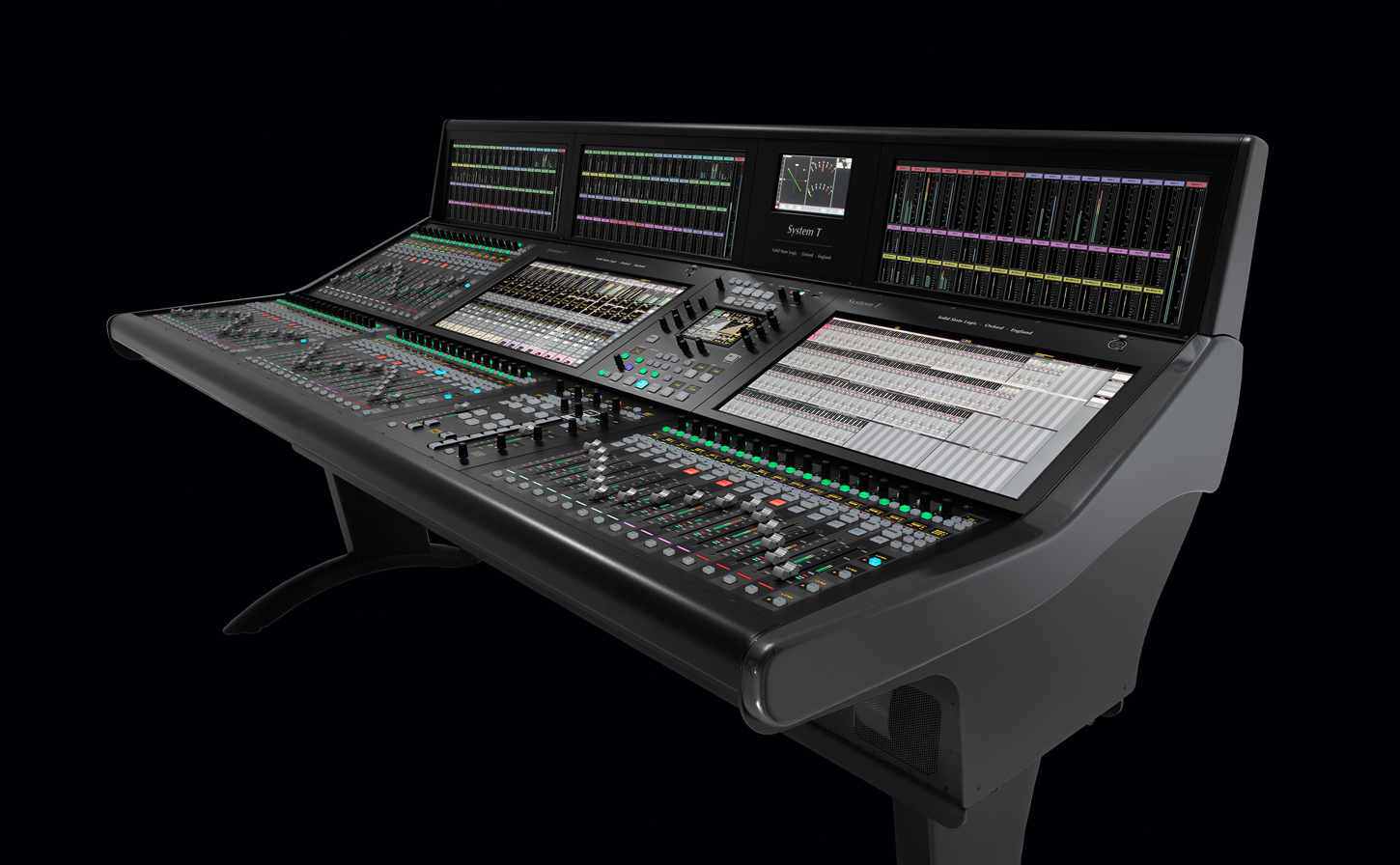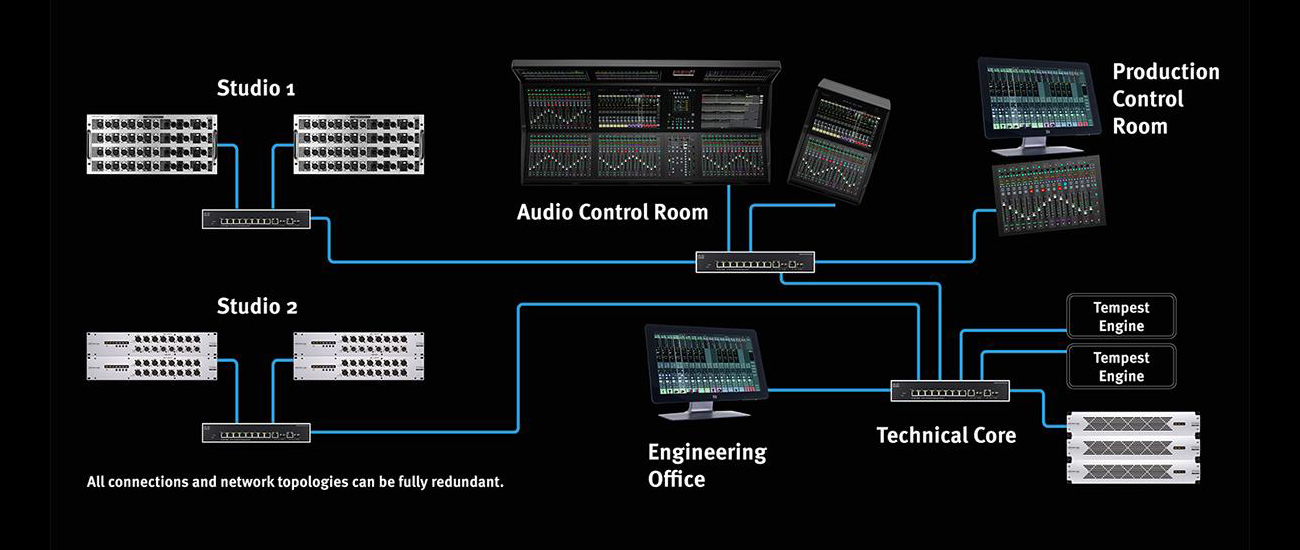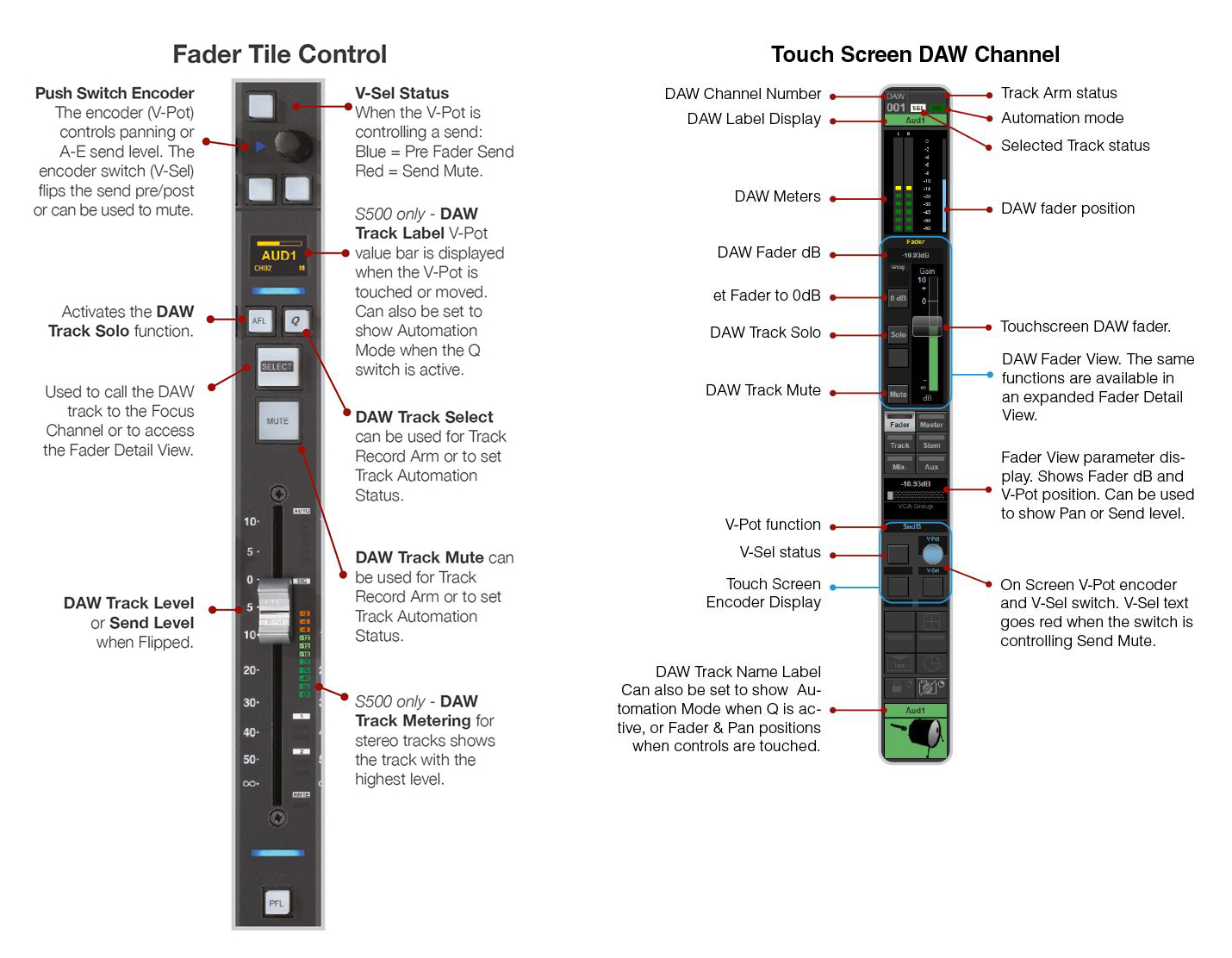
System T is a new generation of dedicated broadcast audio production systems from Solid State Logic developed by incorporating decades of research and customer feedback with truely innovative technology and conceptual design to deliver major advances to the broadcast audio market.
Fully networked production environment
By implementing a fully networked production environment from the ground up, System T delivers new ways to combine multiple control interfaces, processor cores and I/O devices to create previously impossible system configurations.

System Elements
There are three main elements to System T: a Dante AoIP based Routing & I/O system which combines SSL’s own Network I/O range of audio interfaces with over one thousand third-party Dante enabled products delivering true cost savings, almost limitless scalability, interoperability and discoverability; Tempest-based DSP engines that deliver the most powerful and versatile audio processing platform available today; and control interface technology that combines a range of consoles with remote hardware, software and touch screen technology.

Routing & I/O
With System T, Dante AoIP network technology (with complete AES67 and SMPTE2110-30 capability) replaces traditional TDM routing with an ecosystem that offers a wide range of operational and commercial benefits. Dante is a licensed IP audio network technology which uses standard IT infrastructure for audio transport, routing, device discovery and control. Dante is high capacity, incredibly versatile and fully scalable. A single gigabit network connection can carry 512 audio channels at 48kHz, or 256 channels at 96kHz. With 512 audio channels bi-directionally on a 1GB connection, a single 24 Port GB Switch is capable of equivalent routing capacity to a 12,288 by 12,288 TDM router at a fraction of the cost. Expansion of a network is not subject to the square law growth required when expanding TDM routing systems; additional switches and capacity can be deployed without replacing core hardware.
Dante offers fully inter-operable system design; over 350 licensed development partners with more than 1000 devices commercially available enabling you to select and combine devices from different manufacturers with full AES67 and SMPTE 2110-30 audio transport capability for devices that don't support Dante. System T offers full routing control of the Dante network from within our consoles and control interfaces. Routing control can be achieved from an unlimited number of devices or network terminals. Dante employs full plug and play device discovery enabling devices to be moved around the network and re-connected with settings intact. Fully redundant network topologies widely used and proven in many IT applications provide the security required for Broadcast infrastructures.
SSL Network I/O interfaces bring renowned SSL audio performance to Dante networks. They can be used as standalone solutions or used with System T to complete powerful facility wide systems. 13 different devices offer mic/line analogue, MADI, AES and SDI embed/de-embed capability wherever it is required. System T control interfaces and SSL Network I/O control software offer remote control of SSL mic/line I/O across the network.
Processing Engine(s)
Tempest processor engines deploy SSL’s patented Optimal Core Processing (OCP) software using arrayed industrial PC hardware in a controlled operating environment. Housed in a 4RU chassis there are two different engines available, The T80 (offering 800 path capacity) and the T25 (offering 256 path capacity). Paths and processing can be dynamically allocated in real time without interrupting audio. With 3072 inputs and 3072 outputs per engine, System T can handle any large-scale production. Tempest engines can be deployed as mirrored redundant pairs and if required each engine can be placed in separate fire zones. Near instant audio changeover happens via up to 6 Network I/O HC bridging cards, each providing 512 channels of inputs and 512 outputs.

Fully Networked Control Interfaces
SSL has nearly four decades of classic audio console design legacy with many of the hardware and software control surface paradigms taken as standard today having first appeared on an SSL console. System T takes this DNA and creates a new broadcast specific set of control interfaces that combine hardware panels with large tablet style multi-touch screens in a fully networked environment. Multiple compact S300 consoles and modular S500 large format consoles can be combined within a single system and can be combined with Tempest Control Rack (TCRs), remotely located computers running the T-SOLSA application combined with or without touchscreens and remote hardware panels connected direclty via USB. Up to three control interfaces can share a single processor engine simultaneously, facilitating for example, an entertainment production with one surface for a music mix and a second for a production mix using a single engine. Multiple engines can be connected to a single console VLAN and interfaces can be moved between engines. The various approaches to remote control capability enable true facility wide control infrastructure design.
Advanced Broadcast Architecture
System T offers exceptional power and flexibility with up to 3072 input and 3072 output connections. The T80 engine provdes 800 active audio paths and the T25 Engine provides 256. Paths are pooled and consumed dynamically according to user configuration with any console configuration possible within pool limits. Channel or bus paths can be added or reconfigured at any time without rebooting and without interruption to audio. A pool of up to 192 mono mix busses with the T80 Engine or 128 with the T25 Engine can be used as desired within defined maximums for each bus type (providing up to 16 Master Buses, 32 Stems, 32 Auxes, 48 Mix Minus Buses and 64 Track Buses). Paths and buses can be freely configured in a range of formats up to 7.1.4.
Path Processing
Dedicated path processing provides EQ’s (T80 x 800, T25 x 256), Dynamics (T80 x 800, T25 x 256) and Delays (T80 x 400, T25 x 128). The primary signal path has eight process blocks that can be configured in any order using a drag and drop interface. These are preceded by the Path gain trim (and Input selection/conditioning on Channels). The primary path output feeds either the panning and bus routing (channels and stems) or is available as a source in the main console signal routing (buses). Two dynamics sections can be activated in each path to facilitate cascaded Compressor/Limiter configurations, or adding dynamics to the channel direct output, mix minus or track bus send. An insert send accesses additional signal processing in the System T FX Rack or external hardware via the console routing.
FX Rack
The System T FX Rack includes a comprehensive set of SSL’s acclaimed studio quality signal processors with their own dedicated DSP pool. The selection includes loudness metering, additional tone and dynamic shaping, reverbs, room simulation, ambience processing, dialogue noise reduction, signal generation and analysis tools and supports all formats up to 7.1.4. Effects are accessible via the Path inserts, or via the console routing using the Aux and Track buses for parallel time based effects. All settings are saved in the System T Showfiles and snapshot automation.
Remote Software Control
T-SOLSA (the SSL On/Offline Setup Application) is an invaluable tool that can be used offline to prepare for productions or online as a remote control application, directly connected or via suitable wi-fi. The application mirrors all of the console’s functionality without the audio processing: configurations can be built, input routing assigned and named, buses allocated, effects inserted, VCA and mute group subgroups setup and Eyeconix images allocated.
During a production T-SOLSA can be used running on PC’s with or without touchscreen interfaces to provide parallel parameter access and independent monitor controls to enable additional operators to manage supplementary tasks. For example, an assistant could prepare and deal with routing whilst the main mixer focuses on the mix, while a third engineer could remix premixes from the main mix to simultaneously generate a local language version or other mix variant.
T-SOLSA also acts as a useful training tool enabling users to get up to speed offline at their convenience.
Production Automation
System T can be integrated with Axon Cerebrum, Grass Valley Ignite, Kahuna, Ross Overdrive, Sony ELC and Viz Mosart systems. The SSL Broadcast Automation interface provides the production automation system with a remote controlled mixer which follows commands issued from the Automation System (or the vision mixer/switcher) and thus controls the audio mix of the production.
The Automation System works in parallel with the console’s physical controls, so if the audio operator adjusts the level of a channel under automation control, the audio will change level. The fact that the level has changed will also be flagged to the automation system. The parameters available to the Automation System (fader level, on/off etc.) means that the console is likely to be pre-configured for a specific show, to set mic gains, EQs, master bus settings, etc.
This can all be simplified by the creation of projects to work with specific automated productions. Automation can be applied to anything from a single channel up to as many audio channels as the specific production automation system supports, but typically a small number of channels are controlled. The Channel faders under control can be hidden from the operator’s view of the surface, so that the console can be used simultaneously by an operator and the automation system without distraction. Automation can globally be switched on/off.
Immersive Audio
Supporting the demand for Next Generation Audio (NGA) within broadcast content, System T’s flexible architecture provides processing for multiple audio formats for immersive and three-dimensional audio; channel-based, objects, Ambisonics and binaural. Supported formats include ATSC 3.0, Dolby Atmos, and MPEG-H, plus on-board conversion support for Sennheiser AMBEO VR technology.
With the emergence of 3D Immersive Audio, in broadcast as well as in film, SSL’s new 3-axis co-ordinate panning for System T incorporates 2 or 4 channel overhead speakers into the available channel and bus formats. As well as positioning mono and stereo sources in a 3D sound field, System T can accept multichannel 3D sources and fine tune their spatial components as they are added to the final production mix. This is essential in multilingual sports productions where effects and ambience multichannel 3D ‘beds’ will be used extensively as the basis of the individual program mixes.
Supported formats include 5.1.2 and 5.1.4, 7.1.2 and 7.1.4 (with side channels as well as rear channels). A novel 4.0.4 format designed primarily for beds and stems ensures that the centre channel remains exclusively available for dialogue and commentary. The 4.0.4 format is also ideal for the output of the new generation of VR mics that capture a 4 channel ambisonics scene representation. This can then be rendered in a multichannel format for incorporation into an ‘object/bed’ based immersive mix.
Intelligent downmixing means that conventional 5.1, stereo and mono mixes can be created simply by routing a 3D channel or stem to a suitably formatted master bus. Downmix coefficient control of the overhead (top) to floor (bottom) mix and the side channels to front and rear, permits user adjustment of the system derived defaults. An elegant unified approach to divergence processing eliminates the complexity often found in the panning solutions offered on workstations and other digital consoles, which require multiple parameters to determine the balance between the discrete and phantom components of the center and side channel signals.
Partnering the new 3D channel and bus formats is a 12-channel monitoring section. This includes 49 12-channel monitor inputs, configured as a primary monitor input and two 24-channel preselectors, together with a 12-channel AFL monitor bus, and a pair of 12-channel insert points for external processing and rendering engine returns, offering all the monitoring tools required in a 3D production environment.
An additional secondary main monitor output allows use of both conventional monitor speakers as well as a secondary sound bar or other domestic style monitor setup for real world quality checking. A further two stereo Alt outputs can be used for nearfield monitors or for simultaneous secondary program monitoring in multi-language productions. Independent channel level and delay adjustment is available for both main monitor outputs.
Completing the immersive feature set in System T is an extensive collection of processing tools. In addition to all the standard path processing (EQ, Filters, Dynamics 1, Dynamics 2, Delay) including up to 7.1.4 capability, the System T FX rack includes immersive format versions of the Bus Compressor, Multiband Compressor, Enhancer, Dynamic EQ, G flex EQ, All Pass Filter, De-Noiser and Summing Module.
The Sennheiser AMBEO A-B converter works hand in hand with SSL’s 360 transcoder. While the former provides the processing-ready B-format from the Ambisonics AMBEO VR Mic, the latter converts this signal to a broad range of output formats and loudspeaker arrangements, ranging from 4.0. to 5.1.4 and 7.1.4. Broadcast engineers are able to record and process immersive content with far greater ease, and without the need for any additional physical equipment.
DAW control

SSL is at the forefront of hybrid production technology bringing the most comprehensive and streamlined DAW control system ever seen on a broadcast console to System T.
System T DAW Control makes best ergonomic use of the hardware controls within the Fader & Master Tiles and System T’s superior multi-gesture touch screens. The DAW Control system uses a HUI implementation, so is designed primarily for use with Pro ToolsTM and is compatible with ReaperTM, LogicTM and other HUI compatible DAW’s.
DAW control is configured in banks of 8 consecutive channels with a maximum of four banks providing 32 physical console faders for DAW Control which can scroll and bank across an unlimited number of tracks in a DAW. The system can be used to control up to four separate DAW’s. ProToolsTM Memory Locations can also be used to recall specific track layouts.

Hardware control is primarily via the System T Fader Tiles with the faders, switches and encoders mapped to DAW mixer functions instead of System T processing. The faders control DAW Track Level and the encoders Track Panning and Send levels. A Flip function allows the faders to set Send levels. Track Arming and Automation modes can be set via the Q switch.
A DAW Popout software interface available in the Channel View on the touch screen contains buttons to assign the encoder function, setup track automation modes, offers basic transport control, plus channel scrolling and banking buttons and other useful master functions. All these functions together with additional commands available in the HUI protocol which can be mapped to User Keys in the Master Tile as well as incorporated into Event Manager scripts.
A DAW Channel View interface can be called to the screen from the main System T Channel View interface or when a DAW Channel is selected in a Fader Tile. This DAW Channel interface shows additional information and provides touch screen control for an extensive collection DAW track parameters.
DAW control is available with T-Solsa software and will use the port selected in the Setup Options Network page to communicate with a Pro Tools system on another PC or MAC. A System-T fader tile may be connected via USB enabling the T-Solsa PC to function as a remote 16 Fader DAW controller.
